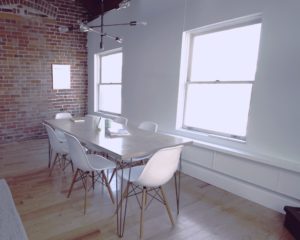 Recent trends in home and office d̩cor have highlighted bright wall colors, but donӪt forget good old traditional gray when you paint. For decades, gray has been a safe go-to hue, but it can look more interesting than you might think. Instead of rejecting gray as dull and unimaginative, consider these reasons to incorporate it into your color scheme.
Recent trends in home and office d̩cor have highlighted bright wall colors, but donӪt forget good old traditional gray when you paint. For decades, gray has been a safe go-to hue, but it can look more interesting than you might think. Instead of rejecting gray as dull and unimaginative, consider these reasons to incorporate it into your color scheme.
Not too hot, not too cold”¦
People often attach specific emotional response to colors. Red, for example, is considered highly stimulating and energetic. At first, it might seem like vibrant, loud colors would provide excitement for any room. However, according to this article from HuffPo Home, if you painted an entire space red, it would likely be distracting and physically hard to look at for long periods of time. It might even make the room feel uncomfortable.
Colors that are usually considered neutral can carry similar emotional weight. White is crisp and clean but often feels cold and clinical, like a hospital. Beige is a color often considered to be dull and boring, so in the wrong space, it might be a little too drab.
Gray, on the other hand, is emotionally neutral. It can exist in the background undetected, splitting the difference between the bright and the boring without over stimulating or inducing yawns.
”¦But not too neutral, either.
Then again, gray can be a striking, stirring color, according to freshhome.com. Close your eyes and think about dramatic clouds, deep shadows, or brushed stainless steel; gray can evoke those visions. With proper lighting, preferably a combination of natural light and well-placed fixtures, gray walls will take on more character than any other color. After all, no one ever called an Ansel Adams photo boring.
Practical and cooperative
Gray can be a practical color choice, too. The right hue will conceal fingerprints and other smudges. At the same time, it can be bright enough to reflect light throughout the room.
What”™s on your wall is usually seen as more important than the wall itself. Whether it”™s a presentation board, family photos, or watercolor art, a loud background can bury these elements. Gray, on the other hand, will not overpower them and will instead allow their colors to stand out.
A company can use their walls as an invitation for employees to add their own color to their workspace. Any time workers are comfortable in their space, it feels more like home, and they are likely to spend more time there.
If you want to add a splash of color here or there, gray goes well with pretty much every other color, so it can connect an exposed brick wall in one room to a bright yellow wall in another. Gray also works to tie in different colored furniture and every kind of floor material without clashing.
Next time you”™re thinking about sprucing up your home or office, consider a little gray to make everything pop. Thinking about painting your home and need a color consultation? We have remarkable individuals who can help. Contact us today to learn more.
